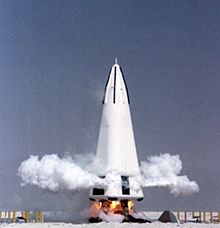New Shepard (spacecraft) and New Shepard: Difference between pages
m moved New Shepard to New Shepard (spacecraft) |
rv |
(No difference)
| |
Revision as of 13:30, 7 September 2006

The New Shepard reusable launch vehicle is a manned rocket which is being developed by Blue Origin, a company owned by Amazon.com founder and billionaire Jeff Bezos, as a commercial system for suborbital space tourism.
The New Shepard makes reference to the first United States astronaut in space, Alan Shepard. It would be assembled in the Blue Origin facility near Seattle, Washington. Blue Origin is starting the process to build an aerospace testing and operations center on a portion of the Corn Ranch, a 165,000-acre land parcel Bezos purchased north of Van Horn, Texas.[1] Blue Origin Project Manager Rob Meyerson has said that he selected Texas as the launch site particularly because of the state's historical connections to the aerospace industry, although that industry is not located near the planned launch site, and the vehicle will not be manufactured in Texas.[2]
Design

The craft is planned to be a vertical take-off / vertical landing system. Its appearance and technical concept are similar to the DC-X. None of its competitors in the nascent space tourism market have disclosed plans to use a similar design.[3] The New Shepard is to be composed of two main elements: a crew module designed to accommodate three or more passengers, and a propulsion module to provide thrust. The composite vehicle has a conical shape, a diameter of 7 metres and a height of 15 metres.
The planned propulsion module is powered by High test peroxide (HTP) and RP-1 kerosene. The total mass of the propellant is 54 tons and the thrust is 1000 kN.
Mission
The New Shepard is expected to be launched vertically from West Texas and then perform a powered flight for about 110 s and to an altitude of 40 km. The craft's momentum would continue to carry it upward in unpowered flight and would decelerate until culminating at an altitude of about 100 km. After reaching apogee the vehicle would perform a descent and restart its main engines a few tens of seconds before vertical landing, close to its launch site.[3]
As a variant, the propulsion and crew module could separate close to culmination altitude, and the propulsion module would perform a powered landing while the crew module would land under a parachute. The crew module can also separate in case of vehicle malfunction or other emergency, using solid propellant separation boosters, in order to protect the passengers, and perform a parachute landing.
The total mission duration of the New Shepard is planned to be 10 minutes.
Development schedule
Initial low altitude flight testing (up to 600 m) with subscale prototypes is scheduled for the fourth quarter of 2006.[2] It could involve up to ten flights. Incremental flight testing to 100 km altitude is planned to be carried between 2007 and 2009 with increasingly larger and more capable prototypes. The full-scale vehicle is expected to be operational for revenue service in 2010, and could fly up to 50 times a year. Clearance from the FAA is needed before test flights begin, and a separate license is needed before commercial operations begin. The company held a public meeting on 15 June 2006 in Van Horn, as part of the public comment opportunity needed to secure FAA permissions.[4] Blue Origin says that once cleared for commercial operation, they would expect to conduct a maximum rate of 52 launches per year. The RLV would carry three or more passengers per operation.[5]
See also
References
- ^ Boyle, Alan (2006-01-13). "Amazon founder unveils space center plans". MSNBC. Retrieved 2006-06-28.
- ^ a b David, Leonard (2006-06-15). "Public Meeting Details Blue Origin Rocket Plans". Space.com. Retrieved 2006-06-28.
- ^ a b "Draft Environmental Assesment for the Blue Origin West Texas Commercial Launch Site" (PDF). FAA.gov. Retrieved 2006-06-28.
- ^ David, Leonard (2006-06-15). "Public Meeting Details Blue Origin Rocket Plans". Space.com. Retrieved 2006-06-28.
- ^ David, Leonard (2006-06-13). "Blue Origin: Rocket plans spotlighted". Space.com. Retrieved 2006-06-28.
External links
- Blue Origin Official Website
- Blue's Rocket Clues (MSNBC's Cosmic Log, June 24, 2006)
